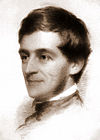Related Research Articles

Monism attributes oneness or singleness to a concept, such as to existence. Various kinds of monism can be distinguished:

Meher Baba was an Indian spiritual master who said he was the Avatar, or God in human form, of the age. A spiritual figure of the 20th century, he had a following of hundreds of thousands of people, mostly in India, with a smaller number of followers in North America, Europe, and Australia.
Pantheism is the philosophical religious belief that reality, the universe, and nature are identical to divinity or a supreme entity. The physical universe is thus understood as an immanent deity, still expanding and creating, which has existed since the beginning of time. The term pantheist designates one who holds both that everything constitutes a unity and that this unity is divine, consisting of an all-encompassing, manifested god or goddess. All astronomical objects are thence viewed as parts of a sole deity.
Maya, literally "illusion" or "magic", has multiple meanings in Indian philosophies depending on the context. In later Vedic texts, māyā connotes a "magic show, an illusion where things appear to be present but are not what they seem"; the principle which shows "attributeless Absolute" as having "attributes". Māyā also connotes that which "is constantly changing and thus is spiritually unreal", and therefore "conceals the true character of spiritual reality".
Ātman is a Sanskrit word for the true or eternal Self or the self-existent essence or impersonal witness-consciousness within each individual. Atman is conceptually different from Jīvātman, which persists across multiple bodies and lifetimes. Some schools of Indian philosophy regard the Ātman as distinct from the material or mortal ego (Ahamkara), the emotional aspect of the mind (Citta), and existence in an embodied form (Prakṛti). The term is often translated as soul, but is better translated as "Self", as it solely refers to pure consciousness or witness-consciousness, beyond identification with phenomena. In order to attain moksha (liberation), a human being must acquire self-knowledge.
Transcendentalism is a philosophical, spiritual, and literary movement that developed in the late 1820s and 1830s in the New England region of the United States. A core belief is in the inherent goodness of people and nature, and while society and its institutions have corrupted the purity of the individual, people are at their best when truly "self-reliant" and independent. Transcendentalists saw divine experience inherent in the everyday, rather than believing in a distant heaven. Transcendentalists saw physical and spiritual phenomena as part of dynamic processes rather than discrete entities.
Moksha, also called vimoksha, vimukti, and mukti, is a term in Hinduism, Buddhism, Jainism and Sikhism for various forms of emancipation, liberation, nirvana, or release. In its soteriological and eschatological senses, it refers to freedom from saṃsāra, the cycle of death and rebirth. In its epistemological and psychological senses, moksha is freedom from ignorance: self-realization, self-actualization and self-knowledge.
Vedanta, also known as Uttara Mīmāṃsā, is one of the six orthodox (āstika) traditions of textual exegesis and Hindu philosophy. The word "Vedanta" means "conclusion of the Vedas", and encompasses the ideas that emerged from, or aligned and reinterpreted, the speculations and enumerations contained in the Upanishads, focusing on either devotion or knowledge and liberation. Vedanta developed into many traditions, all of which give their specific interpretations of a common group of texts called the Prasthānatrayī, translated as "the three sources": the Upanishads, the Brahma Sutras and the Bhagavad Gita.

Advaita Vedanta is a Hindu-tradition of textual exegesis and philosophy and a Hindu sādhanā, a path of spiritual discipline and experience. In a narrow sense it refers to the scholarly tradition belonging to the orthodox Hindu Vedānta tradition, with works written in Sanskrit, as exemplified by the Vedic scholar and teacher (acharya) Adi Shankara ; in a broader sense it refers to a popular medieval and modern syncretic tradition, blending Vedānta with Yoga and other traditions and producing works in vernacular.
Satguru, or sadguru, means the 'true guru' in Sanskrit. The term is distinguished from other forms of gurus, such as musical instructors, scriptural teachers, parents, and so on. A satguru has some special characteristics that are not found in any other types of spiritual guru. Satguru is a title given specifically only to an enlightened rishi or sant whose life's purpose is to guide the initiated shishya on the spiritual path, the summation of which is the realization of the Self through realization of God.

Dvaita Vedanta ;, is a sub-school in the Vedanta tradition of Hindu philosophy. The term Tattvavada literally means "arguments from a realist viewpoint". The Tattvavada (Dvaita) Vedanta sub-school was founded by the 13th-century Indian philosopher-saint Madhvacharya. Madhvacharya believed in three entities: God, jiva (soul), and jada. The Dvaita Vedanta school believes that God and the individual souls (jīvātman) exist as independent realities, and these are distinct, being said that Vishnu (Narayana) is independent (svatantra), and souls are dependent (paratantra) on him.
Karma is a concept of Hinduism which describes a system in which beneficial effects are derived from past beneficial actions and harmful effects from past harmful actions, creating a system of actions and reactions throughout a soul's (jivatman's) reincarnated lives, forming a cycle of rebirth. The causality is said to apply not only to the material world but also to our thoughts, words, actions, and actions that others do under our instructions.
Paramatman or Paramātmā is the Absolute Atman, or supreme Self, in various philosophies such as the Vedanta and Yoga schools in Hindu theology, as well as other Indian religions like Sikhism. Paramatman is the "Primordial Self" or the "Self Beyond" who is spiritually identical with the absolute and ultimate reality. Selflessness is the attribute of Paramatman, where all personality/individuality vanishes.
In Indian philosophy and some Indian religions, samskaras or sanskaras are mental impressions, recollections, or psychological imprints. In Hindu philosophies, samskaras are a basis for the development of karma theory.

God Speaks: The Theme of Creation and Its Purpose is the principal book by Meher Baba, and the most significant scripture used by his followers. It covers Meher Baba's view of the process of creation and its purpose and has been in print continuously since 1955.
The causal body, originally Karana-Sarira, is a yogic and Vedantic concept that was adopted and modified by Theosophy and from the latter made its way into the general New Age movement and contemporary Western esotericism. It generally refers to the highest or innermost body that veils the atman or true Self.
Videha mukti refers to the moksha after death. It is a concept found in Hinduism and Jainism in relation to ending the samsara. The concept contrasts with Jivanmukti, which refers to achieving "liberation while alive". The concepts of Jivanmukta and Videhamukta are particularly discussed in Vedanta and Yoga schools of Hindu philosophy.
Para Brahman or Param Brahman in Hindu philosophy is the "Supreme Brahman" that which is beyond all descriptions and conceptualisations. It is described as the formlessness that eternally pervades everything, everywhere in the universe and whatever is beyond.
According to three bodies doctrine in Hinduism, the human being is composed of three shariras or "bodies" emanating from Brahman by avidya, "ignorance" or "nescience". They are often equated with the five koshas (sheaths), which cover the atman. This doctrine is an essential doctrine in Indian philosophy and religion, especially Yoga, Advaita Vedanta, Tantra and Shaivism.
Jivatva means – the state of life or the state of the individual soul. Jivatva is the state of life of the Jiva, the living entity, which is a particular manifestation of Atman, the embodied being limited to psycho-physical states, and the source of avidya that suffers (repeated) transmigration as result of its actions. Until ignorance ceases the Jiva remains caught in experience of the results of actions bringing merit and demerit, and in the state of individuality (jivatva), and so long as the connection with the intellect as conditioning adjunct lasts, so long the individuality and transmigration of soul lasts.
References
- ↑ The Teachers of Emerson, John S. Harrison, New York: Sturgis & Walton, 1910.
- ↑ Emerson: The Mind on Fire, Robert D. Richardson Jr, Berkeley: University of California Press, 1995 pp. 65-66.
- 1 2 Over-soul, from Essays: First Series, Ralph Waldo Emerson, 1841
- ↑ India in the United States: Contribution of India and Indians in the United States of America, Sachin N. Pradhan, SP Press International, Inc., 1996, p 12.
- ↑ God Speaks, The Theme of Creation and Its Purpose, Meher Baba, Dodd Meade. 1955. Sec. Ed. pp. 1 ff., 156, 172
- ↑ "Sanskrit: Param". Archived from the original on 2007-02-07. Retrieved 2007-02-06.
